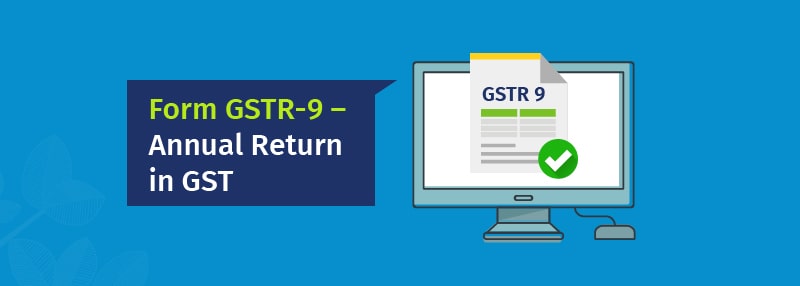It’s been more than 15 months since the introduction of GST and by now, most of the businesses registered under GST are quite familiar in filing GST returns i.e. GSTR-1 which needs to be filed either quarterly or monthly and GSTR-3B on a monthly basis. Now, it’s time for businesses to file yet another return ‘Annual GST return in GSTR-9 Form’.
On 4th September 2018, the new GSTR-9 format for filing annual return was notified by CBIC which details the information to be furnished. Â In this blog, we will understand the following:
What is GSTR-9?
Who Should File GSTR-9?
Different types of GST Annual returns
Due date to File GSTR-9
Penalty for Late Filing of GSTR-9
What is GSTR-9 Form?
Form GSTR-9 is an annual return to be filed by the businesses registered under GST. In Form GSTR-9, you need to declare the consolidated details of outward supplies, inward supplies, GST payable and ITC claimed for the previous financial year. For the previous financial year 2017-2018, you need to furnish the consolidated details of supplies made or received from July, 2017 to March 2018.
All you need to do here is to consolidate the details which you have already furnished through GSTR-3B and GSTR-1 either on a monthly or quarterly basis and declare it in the prescribed format of GSTR-9.
Who Should File GSTR-9 Form?
The annual return in GSTR-9 form needs to be filed by all the businesses who have obtained regular GST registration. In other words, the annual return in form GSTR-9 is not required to be filed by the businesses registered under Composition scheme, Input Service Distributor, casual taxable person, non-resident taxable and e-commerce operator.
Different Types of GST Annual returns
The following are the different type of annual GST returns applicable to the businesses.
| Type of Business | GST Annual Return Form |
| Regular Registered Business | GSTR-9 Form |
| Business opted for Composition scheme | GSTR-9A Form |
| E-commerce Operator | GSTR-9B Form |
Currently, only Form GSTR-9 format has been notified by the CBIC and other formats are yet to be notified. Over and above the annual return form GSTR-9, the business who have obtained regular GST registration and if the aggregate turnover during a financial year exceeds 2 crore rupees, they are required to submit audited annual accounts and a reconciliation statement by filing GSTR-9C.
Form GSTR-9 Due Date
As prescribed in the GST Act, all the annual returns should be filed on or before the 31st of December following the end of such fiscal year. Thus, the GSTR-9 form for July’17 to March’18 is 31st December, 2018, unless it is extended through a notification. Currently, the provision for filing of GSTR 9 form in GST portal is yet to be made available.
Penalty for Late filing of GSTR-9 form
Failure to furnish the annual return in GSTR-9 form will attract penalty. A late fee will be levied if GSTR-9 is not filed with the due date. Late fees for failure to furnish GSTR-9 is 200 Rs per day (CGST 100 Rs + SGST 100 Rs). However, the maximum amount of penalty cannot exceed 0.25% of the total turnover of the taxpayer.
